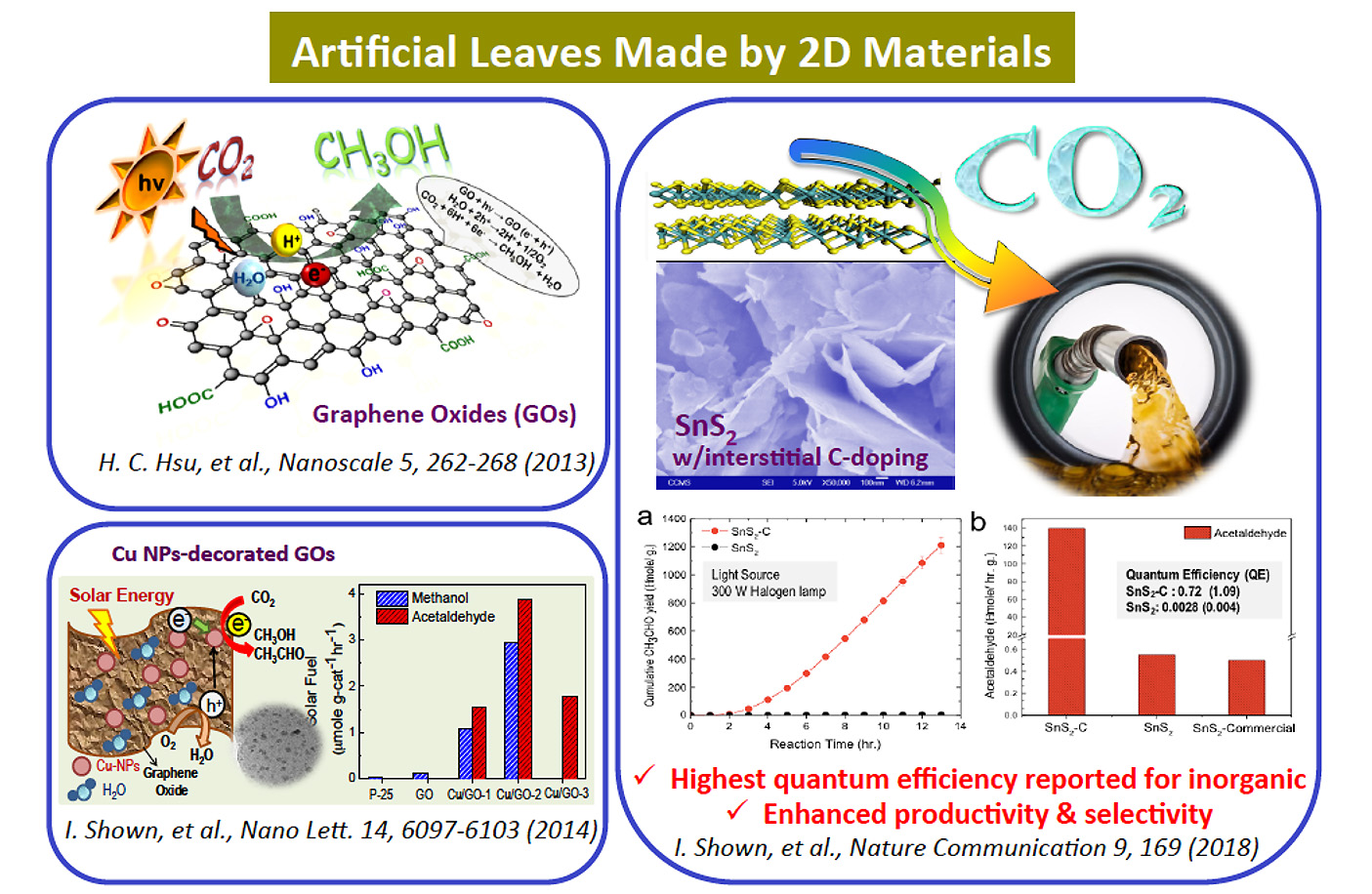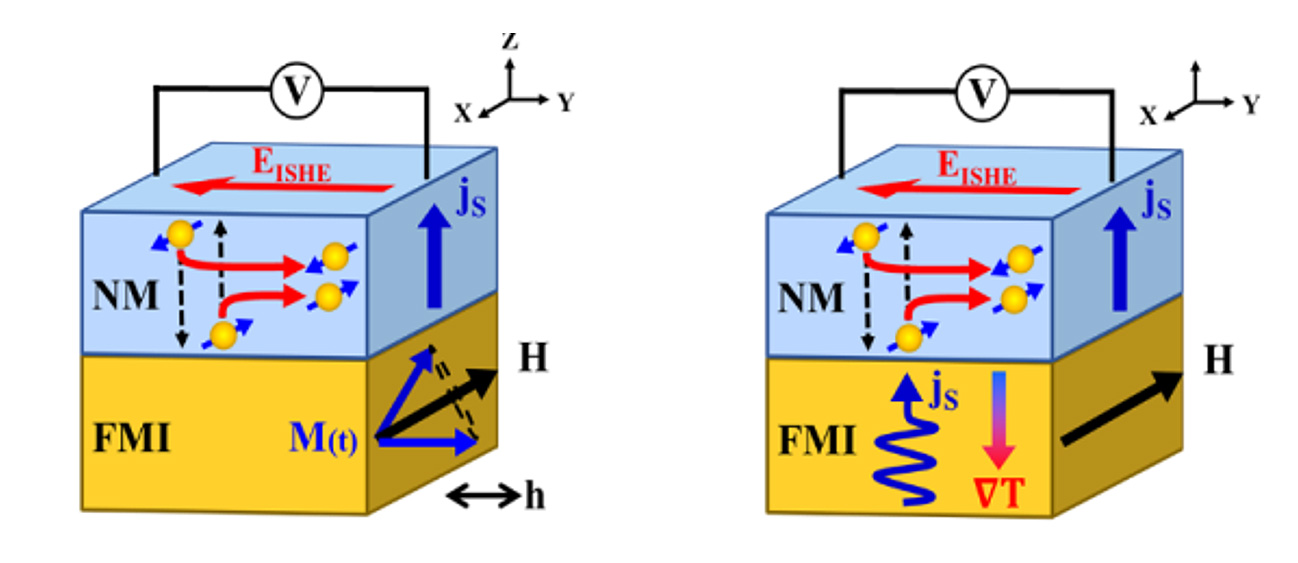
凝態中心林麗瓊博士主持
研究成員:
林麗瓊博士(臺大凝態中心)
林昭吟博士(臺大凝態中心)
王立義博士(臺大凝態中心)
林倫年博士(臺大凝態中心)
陳學禮教授(臺大材料系)
張之威博士(臺大凝態中心)
吳恆良博士(臺大凝態中心)
白奇峰教授(臺大材料系)
王俊凱博士(臺大凝態中心)
鄭鴻祥博士(臺大凝態中心)
1. Atomic Engineering And Molecular Designs For Boosting CO2 Conversion Efficiency And Selectivity:

Schematic illustration of the CO2 reduction via photocatalytic, solar-fuel process; the new 2D structures, (left top) graphene oxide (GO), (left bottom) hybrid Cu nanoparticles-GOs, and (right) SnS2 nanosheets doped with carbon, have been demonstrated as effective photo-catalysts for solar-fuel. The SnS2-C can give ~ 0.7% solar-fuel efficiency, by far the highest among the inorganic photo-catalyst.
2. Atomic Engineering Of Thermoelectric Materials And Devices
Thermoelectric devices can convert waste heat into electricity, or they can be operated in reverse by converting electricity into refrigerating power. These devices will serve as new green energy resources as their operation does not emit greenhouse gases. Furthermore, because they are solid-state materials, they can be compact and durable. Our recent discovery of room temperature ballistic thermal conduction has stimulated us to invent new thermoelectric devices with superior efficiency. Besides, we are actively engaging unexplored domains in phononics, including interactions of ballistic phonons with photons and electrons.
3. Atomic/Molecular Probing And Interface Engineering For Improving Lithium-sulfur Battery:
Our long term goal is to advance the energy storage and conversion science and technology through in situ experiments. Currently, Interfacial Materials Chemistry group focus on several themes related to structure and reactivity at solid-liquid interfaces. Our research efforts are focused on the fundamental understanding of the structure-property and reactivity of materials at the interface of electroactive and photoactive materials for energy applications including next-generation battery devices (lithium-based batteries). We utilize in situ vibrational spectroscopy (surface-enhanced IR and Raman spectroscopy), X-ray diffraction and on-line differential electrochemical mass spectrometry to investigate the reaction processes. We aim at achieving fundamental understanding of these processes that can be used to improve the reactivity and stability of materials.
Figure (a) Schematic figure of Li-S battery and (b) Illustration of the operando Raman/FT-IR/UV-Vis measurements
4. Atomic Engineering Of Spintronic Materials Towards Ultimate Low Power-Consumption Devices
Dr. Jauyn Grace Lin has successfully used a cavity type ferromagnetic (FMR) system to combine with a homemade set-up of electrical circuit to form an FMR driven spin-current pump-and-probe system (FMR-SP), which is the only system of its kind in Taiwan. This system provides microwave to activate the spin procession in ferromagnet (FMI) for transferring the spin moment into the neighboring normal metal (NM) in which spin current can be converted into charge current with strong spin orbital coupling; thus, it serves as a functional detector to detect the efficiency of spin-current generation in relevant devices. In addition, Prof. S. Y. Huang at Physics Department also has a homemade system based on the longitudinal spin Seebeck effect (LSSE) with a vertical temperature gradient (VTG), which could also effectively generate the pure spin current. As indicated in the following diagram, the FMR-SP (left) and LSSE-VTG (right) will serve as two core techniques to characterize the efficiency of spin-current generation as demonstrated in the following diagram.

(a) Schematic figure of FMR-SP (left) and LSSE-VTG (right) measurements.
Taiwan has a great opportunity to lead the world if creative material design can be realized in the Center. The proposed two systems are: (1) FMI layer = Perovskite layered oxides with NM = Pd, Pt, W, Ta; and (2) FM layer = Co, CoFe with NM = IV-IV semiconductors. The Perovskite oxides R1-xSrxMnO3 with R = rare earth and the IV-IV semiconductor Ge1-xSnx will be synthesized by pulse laser deposition (Dr. Jauyn Grace Lin) and the molecule beam epitaxy (Dr. Hung-Hsiang Cheng) respectively. Atomic replacement of R with Sr in R1-xSrxMnO3 and the doping of Sn Ge1-xSnx not only modulate the conduction/valence band, but also enlarges the spin-orbit band, which is the essential quality for SOC layer.
5. Atomic Understandings And Development Of Guiding Principles With Theoretical Framework
We intend to establish a platform of computational simulation support and/or theoretical modeling for the experimental groups under the thrust area III. Theoretical approach through this platform will help the experimental groups to deduce and thus understand physical and chemical key properties of the proposed materials from the atomic-scale point of view. We aim to construct appropriate structures of proposed materials (two dimensional systems or layered materials) based on which geometries his group will simulate, by using the first principle methods, the physical and/or chemical properties. In addition, this platform will open to the thrust area I and thrust area II and the first principle simulation support will be provided for those involved in these two thrust areas.
The major scientific issues are (i) theoretical prediction or determination of the geometrical and electronic structures of the materials (atomic scale of structures), (ii) first principle simulations of the spectroscopy features of the materials (atomic accuracy of measurements) and (iii) theoretical modeling of possible chemical reactions on the surfaces or at the interfaces of the materials constructed or obtained by (i) and (ii) (atomic functionalities).
The subject (i) involves accurate calculations of the geometrical structure that will be used to simulate the electronic properties such as band-gap, partial density of state, and partial charge distribution.
The subject (ii) intends to confirm the validity of the resulting material structures that will be determined in the subject (i). Various spectroscopic features of the materials will be simulated by the first principle simulation methods, which spectroscopy involves phonon/vibration spectroscopy (THz, IR, and Raman), optical spectroscopy (absorption and emission), and core electron spectroscopy (XAS, XPS, UPS, ELNES, EXAFS and EELS). Scanning tunneling microscopy (STM) images will also be simulated as necessary.
The subject (iii) will focus on study of chemical properties of the materials such as solar cells. The major target is to find a way to generate chemically activated atomic sites in the proposed materials; more specifically the relationship between the type and size of defects and chemically activated atomic sites will be elucidated from the theoretical point of view. A guiding principle of a band-engineering targeting efficiency and selectivity for a specific chemical reaction or specific physical properties will be explored. The subject III also intends to carry out the first principle simulations study on the electron-phonon coupling, phonon-phonon coupling, and phonon-vibration coupling that are one of the important, fundamental issues of energy conversion processes.

